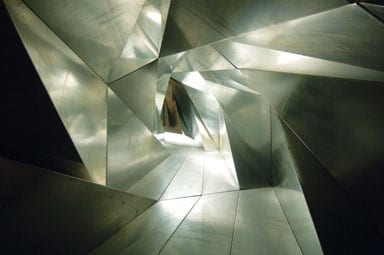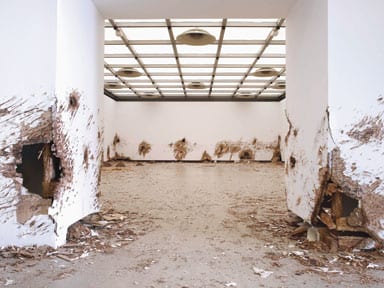
words Mark Rappolt
There’s a travel guide that begins its entry on London’s Southbank Centre with the following warning: “It is made up of a number of rather ugly buildings.” Given that, you might easily think that the Hayward Gallery’s big summer show, with its confrontational title Psycho Buildings: Artists Take on Architecture, is supposed to evoke images of American Psycho’s Patrick Bateman screaming “you’re an ugly bitch. I want to stab you to death and then play in your blood”, but wielding a pneumatic drill rather than a chainsaw and playing in a puddle of concrete rather than blood.
Yet while Psycho Buildings may in the first instance bring to mind architectural movements like “Westism” or “the Fritzlesque”, that’s merely the kind of marketing strategy designed to grab your attention. After all, the Hayward is already one of the most celebrated (and, of course, derided) examples of Brutalist architecture in its own right. Instead, the term “psychobuilding” derives from 1980s art idol Martin Kippenberger’s photographic catalogue of architectural oddities – buildings that might be termed psychotic in the sense that they seem to reject “reality” and go against the modern city’s regulated, gridlocked norm. And riffing off that, nine artists and one architecture firm have run amok through the gallery.
The broad themes of the show are introduced by two works: Ernesto Neto’s Life Fog Frog… Fog Frog, a grey polyamide tented dome, supported on a bone-like plywood frame, and Do Ho Suh’s Fallen Star 1/5, a scale model of a traditional Korean chalet (not far removed from a traditional Swiss chalet, it has to be said) crashing into a New England apartment block. A dome full of pores and dangling testes, as well as some sort of clove-scented inwardly distended anus, the first sets up the idea of architecture as fragile, delicate and porous as our skins. The second introduces the idea of buildings as ciphers for cultural and psychological identity, telling the story of the displacement Suh felt on leaving his native Seoul for his new home in America.
Moving swiftly around, Atelier Bow-Wow’s Life Tunnel recreates an Aliens-like crawl through steel ducting that’s had the angular treatment normally associated with Frank Gehry and Zaha Hadid. Los Carpinteros presents Show Room – a room that is frozen (on a series of cords) as it explodes (a bit too neatly) inwards. Michael Beutler offers a slightly ratty chickenwire and tissue-paper maze. Tomas Saraceno offers a two-storey, transparent, plastic geodesic dome complete with double airlocks, that allows groundlings to look up at privileged “floaters” on the upper deck. Rachel Whiteread shows off a rather disappointing village of illuminated dolls’ houses. Gelitin coughs up a rooftop boating lake and the image of escaping the Southbank’s concrete jungle and paddling off into the sunset. (It sounds silly but this fantasy is both an antidote and a palliative to urban life.) While, perhaps in the same vein, Tobias Putrih creates a wooden cinema showing movies of things like Constant’s 1960s utopian city schemes and Gordon Matta-Clark’s building cuts, which serve to give a backdrop of historic architecturally related fantasies to the rest of the show.
But if you really do want the playing in a puddle of blood stuff, then Mike Nelson’s To the Memory of HP Lovecraft, 1999, is the most truly Batemanesque room in the show. It’s an environment that has been clawed at and possibly chewed by some sort of wild animal. And like some crime scene investigator you start reading (and thus experiencing) your environment, measuring the height and size of the beast from the clues it has left behind, and tying to understand a vague logic that has caused it to create a series of anthill-like mounds of masticated rubble.
You could argue, of course, that each individual work in this show is, while certainly attention-grabbing, ultimately somewhat slight – that Saraceno has offered little more than a high-tech bouncy castle, Gelitin nothing better than an unusually located boating lake, Putrih a cheap cinema, and Nelson the set for the latest instalment in the Saw franchise. And you’d probably be right. However, collectively Psycho Buildings is greater than the sum of its parts. It’s an experience that makes you conscious not only of the physical and psychological properties of the spaces we inhabit, but also of the contingency and adaptability of the built environment around us – the fact that it does not have to be like this; it could be like that. Curator (and Hayward director) Ralph Rugoff has exploited almost every available inch of a sometimes static and ungainly building, and he does this in a way that’s dynamic, entertaining and easy on the eye. And you can’t help wondering why architecture exhibitions so often do the opposite.
On seeing Gehry’s Bilbao Guggenheim, Philip Johnson, the godfather of American modernism, is supposed to have said: “When a building is this good, who gives a fuck about the art?” Psycho Buildings is art’s revenge.
top image Atelier Bow-Wow’s Life Tunnel ©Stephen White

Do Ho Suh’s Staircase V

Gelitin’s boating lake

Mike Nelson’s To The Memory of HP Lovecraft, 1999


















